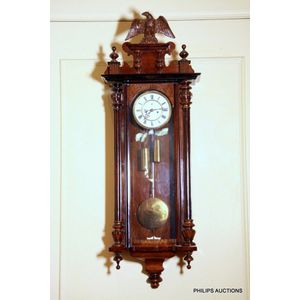19th Century Vienna Regulator Clock with Eagle Crest
You must be a subscriber, and be logged in to view price and dealer details.
Subscribe Now to view actual auction price for this item
When you subscribe, you have the option of setting the currency in which to display prices to $Au, $US, $NZ or Stg.
- Pendulum - The pendulum was discovered around 1602 by Galileo Galilei, and was adopted for time keeping by the Dutch mathematician and natural philosopher, Christiaan Huygens, who excelled in astronomy, physics, and horology.
The pendulum comprises a metal rod usually of brass or steel with a metal disk, known as a bob, at the end. The movement of the pendulum is driven by weights or a spring, and as a pendulum swings in a regular arc, it was found accuracy could be controlled to within a few seconds a week.
Timekeeping can be adjusted by changing the height of the bob on the rod, making the pendulum either swing slower or faster.
The disadvantage of the pendulum was that changes in temperature also changed the length of the pendulum, interfering with the accuracy of the clock, and so in the 18th century two types of mercurial pendulums were invented which countered the movement in the steel rod.
The pendulum was the world's most accurate timekeeping technology until the invention of the quartz clock, regulated by a quartz crystal, in 1927. - Finial - An architectural decoration, found on the upper parts of of an object. On furniture they are usually found on pediments, canopies and shelf supports. On smaller ceramic or silver items, such as spoons, they may decorate the top of the item itself, or the lid or cover where they provide a useful handle for removal.
Finials have a variety of shapes and forms. They may be urn-shaped, baluster shaped round or spiral, but usually taper into an upper point. Many real life shapes may also be used as finials, such as pineapples, berries, pinecones, buds, lotus and acorns. Sometimes animals such as a lion are depicted, or fish and dolphins. - Chapter Ring - A separate metal plate on the face of a clock, on which the numerals for the hours and sometimes parts of the hours, are displayed, usually wheel shaped and sitting on top of the dial plate. The chapter ring is often a feature of the clock and can be silvered or enamelled to stand as a contrast to its background. The hours are usually shown in Roman numerals, although in the late 19th and earlt 20th century, Arabic numerals became fashionable.
- Subsidiary Dial - On a clock or watch, a subsidiary dial, also called an auxiliary dial, is a dial that is secondary to the main dial and may show seconds, day of the week or month, or strike silent. A subsidiary dial may be within our outside the main dial, and a clock or watch may have several subsidiary dials.
- The Eagle - The eagle has been a symbol of power, victory, and strength for centuries. It is often associated with bravery, prowess, and dominance, and has been used as a symbol by many cultures and civilizations throughout history.
In ancient Greece, the eagle was associated with the god Zeus, who was considered the king of the gods and the ruler of the skies. In many cultures, the eagle was seen as a messenger between the physical world and the spirit world, and was associated with the sun and the sky.
In the Roman Empire, the eagle was the symbol of the Roman army, and was displayed on the standards of the soldiers to show the power and authority of the empire. In medieval Europe, the eagle was used as a symbol of power and victory by monarchs and rulers, and was often depicted in art and architecture as a symbol of strength and courage.
In modern times, the eagle continues to be a symbol of power, victory, and strength. It is often used as a symbol by nations and organisations, and is frequently depicted in art and on monuments to commemorate important events and achievements.
The eagle's powerful appearance, combined with its association with freedom, courage, and dominance, makes it a popular and enduring symbol of power and victory.
This item has been included into following indexes:
Visually similar items

A late 19th century Vienna single weight regulator wall clock, 120 cm high. The Estate of Stanley Crawford Stevens.

A walnut Vienna regulator wall clock late 19th century. The clock has a white enamel dial, hourly and half hour gong striker. Height 135 cm

A George III musical bracket clock, J Thwaites, London, circa 1811, the mahogany brass lined bell top case with rococo finials, each angle mounted with brass herms trailing leafy buds. The sides with brass handles above foliate case sound frets with quarte

American wall clock, no key, has pendulum, approx 60 cm high, 32 cm wide
